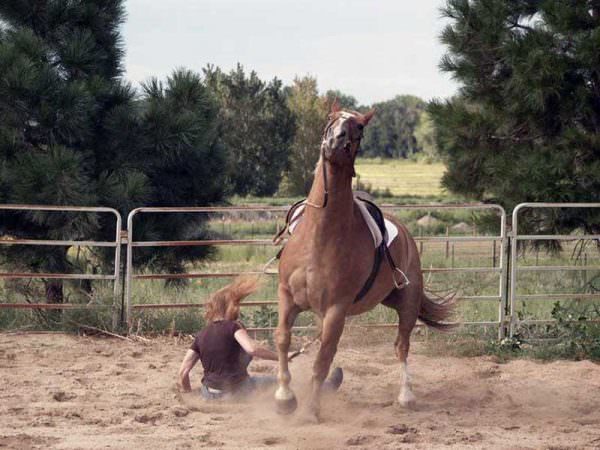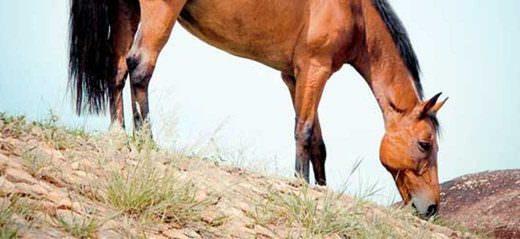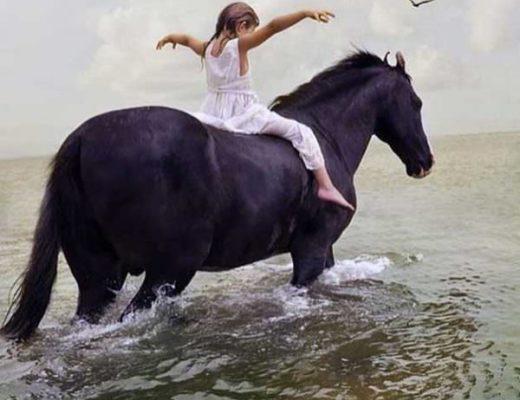Clinicians are a dime a dozen in today's horse world, and often they give out really useless information to help wheedle you into paying for a clinic or training or to hock some new gadget they made. And other times they give out advice that is downright dangerous for the average equestrian.
Our clinician today has gained a lot of popularity for Cowboy Dressage. Eitan Beth-Halachmy gives us an excellent visual lesson today on how to train your horse to dump you out of the saddle.
What I want to draw your attention to is the aids he's encouraging for teaching this young horse to move forwards. Leaning his shoulders forwards and bringing his butt slightly out of the saddle.
Think really hard about what else might cause you to make these motions in the saddle? Perhaps when you've lost your balance and are just beginning to fall out of the saddle?
 Most riders don't fall off the back of their horse, they fall forwards out of the saddle or off to one side or the other.
Most riders don't fall off the back of their horse, they fall forwards out of the saddle or off to one side or the other.
When we become tense our natural instinct is to move towards the fetal position – which is bringing our upper body forwards towards the horse's head/neck and our knees up towards our chest. Do you want your horse to run forwards as your losing your balance thinking you want him to?
Yes, this aid makes sense in one respect – you're attempting to lighten the weight in the saddle to encourage your horse to move out underneath you. But does that outweigh the potential risk of teaching him to bolt out from underneath you when you lose your balance?

I'm not under the impression that it does, and instead I prefer to teach horses to stop and stand still as their first response to this kind of movement in the saddle. I'd rather them feel confident moving forwards with my full weight in the saddle than bolting away at the first sign of an unbalanced rider.
Safety first, always.
Planning Ahead
Any aid you plan to implement with your horse you should spend at least a few moments thinking about potential drawbacks. If you teach your horse to rear every time he hears a certain noise, are you going to have a horse rearing every time someone in the same arena kisses to their horse?
Clinicians aren't know-it-alls
Believe it or not, just because you teach at clinics does not mean you know everything (or anything) or the best or most right thing for every situation. What it means is that someone is willing to hire you as a clinician, period.
Remember to use all of your senses when you sit down to audit or participate in a clinic. Don't rely solely on your ears to filter the information being given to you. Does the explanation mesh with what you are seeing with your eyes, or even feeling with your gut?
Now go out there and avoid teaching your horse to dump you out of the saddle, even if some big-name-clinician says it's right and okay.








I’ve been taught, but several instructors, to lighten the seat for a forward transition … but NOT by sitting forward. Rather, you stretch up slightly, which gives the feel of lightening your seat, just before you ask for the transition. Long term affect being that your horse begins to step into the new gait, eventually, from the slightest stretching up of your spine. Seems a better postural solution than Eitan’s suggestion, as well as having a better long term affect (in his scenario, at what point can you stop leaning forward?). Interesting …
this fellow reminds me of Caesar Milan and his ‘assertive energy’ mantra with dogs. The last thing I want to do is lean forward on the horse. The impulsion forward has to come from behind, so how the heck do you generate that by leaning forward?
As he sat in the saddle before the horse moved I concluded Eitan is not setting a good example of riding in any classical sense. He is supposed to be introducing/promoting principles of horsemanship for Western Dressage and he rides in a chair-seat position with and overactive scooping action. His accent is cute but his skills are not worthy of a mentor.